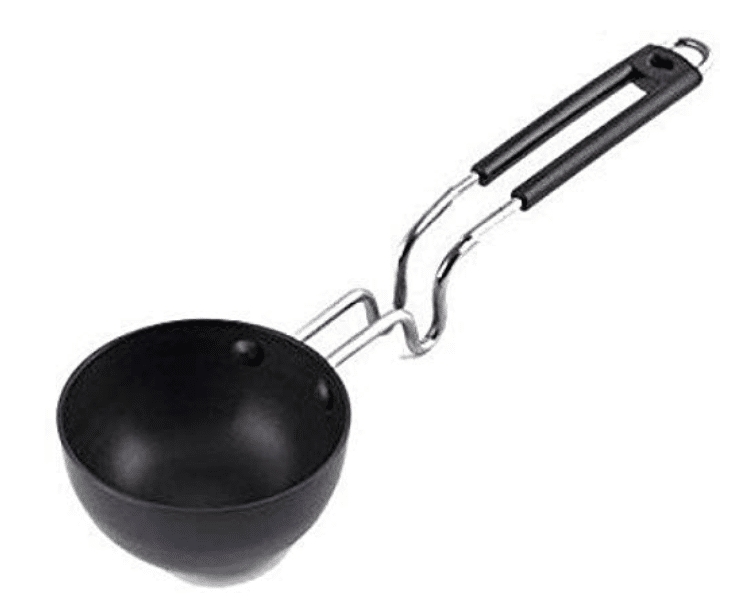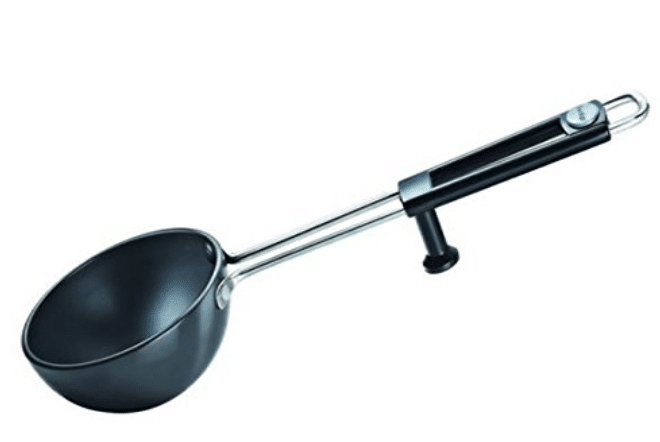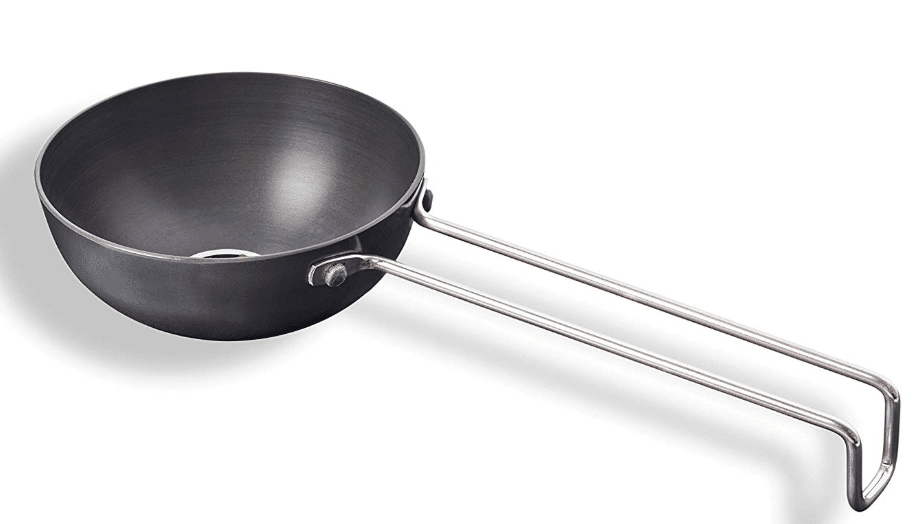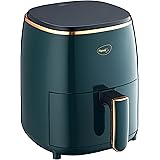Between Stainless Steel, Hard anodized and Non-stick tadka pans – we recommend a Hard Anodized Tadka Pan as it is long-lasting, easy to clean and above all, is non-reactive to acidic foods and does not produce toxic fumes when used over a period of time.
Table of Contents
Best Tadka Pan in India
Our Recommendations Based On The Review:
1. Usha Shriram hard anodised tadka pan with sleeve, 100 mm

Butterfly Smart 750 Watts Mixer Grinder with 4 Jars | 3 Stainless Steel Multipurpose Jars & 1 Juicer Jar | ABS Body | Heavy Duty Motor | 2 Years Manufacturer's Warranty | Grey
Prestige PIC 20 1600 Watts Induction Cooktop |Indian Menu Option |High Voltage Surge Protection| Automatic Power & Temperature Adjustment|1 year Warranty |Black
Cookwell Bullet Mixer Grinder (5 Jars, 3 Blades, Silver) - Copper, 600 Watts - 2 Year Warranty
Pigeon Healthifry Digital Air Fryer, 360° High Speed Air Circulation Technology 1200 W with Non-Stick 4.2 L Basket - Green
- 2.4 mm Thick aluminium body: Durable Tadka Pan that heats up quickly and uniformly
- 2.4 times harder then steel, non-toxic and non-staining, non-reactive with foods, not spoilt by high heat, metal ladles can be used
2. Prestige Hard Anodised Tadka Pan, 100 mm

- Material: Hard anodized aluminum
- Riveted handle made of Bakelite: Cool touch handle that does not become loose over time
- Heats evenly, cooks faster.
3. Embassy Hard Anodised Tadka Pan/Vagariya, 400 ml, Gas Stovetop Compatible, Black

- Non-toxic and non-staining
- Heats faster and evenly
- Gas Stovetop Compatible. Not suitable for Induction cooktops
- Strong and durable
Our Review Process
The factors that matters while buying tadka pans.
1. The Importance Of Tadka Pan In The Kitchen
The process of tempering (adding tadka) lasts only a few minutes and is an integral part of Indian cooking. Tempering is meant to release the oils and flavors of core ingredients, and doing so in a pan with hot ghee or oil adds to the aromatic experience.
Used routinely to temper dals, dhoklas and kadhis, tadka pans go through significantly high temperatures on a daily basis. Used on the gas stove mostly, though some induction stove compliant ones are also available these days, a good tadka pan should be scratch-resistant, should be easy to clean with an ergonomic design, but above all, it should be able to withstand high heat without the coating breaking down.
2. Design
Most tadka pans are designed to have a sturdy handle that does not heat up. Also called ‘perma cool’, these handles are built to withstand high temperatures and provide safety and make it convenient to quickly add the ingredients in the pan into the dal/kadhi. Needless to say, these handles should be lightweight yet strong.
All tadka pans have a disproportionately long handle. So that the handle does not tilt the pan to one side, there is always an in-built stand somewhere in the middle of the handle to help keep the pan resting on the burner. A stand or support such as this is a must.
3. Size of the Pan
This can vary depending on the family-size and also the size of the burner. Often people make the mistake of buying really small sized pans for large burners. This ensures that the tadka pans never really settle well on the burner, increasing the chances of spills and even mishaps.
4. Weight
Since we are looking for the best tadka pans for home kitchens, a very heavy one would be inconvenient for daily use. Usually operated by one hand, tadka pans for this kind of usage need to be lightweight.
5. Material Used
This point, to our mind, is most crucial. A tadka pan goes through high heat day after day. The material should be such that it can withstand high temperatures. It should be made using non-toxic and non-reactive material. The steel tadka pan is the best one out there comprising all these qualities.
What Is Hard Anodized Cookware?
There was a time when most cookware used to be made of aluminum because of its superior heat-conducting abilities. Then came concerns about the side effects of ingesting aluminum on kidneys and other vital organs. Acidic liquids tend to react with aluminum, which in turn can enter the body through the food consumed.
Gradually, quality aluminum cookware began to be coated with other materials, like stainless or a non-stick coating of Teflon. Over the years, there have been several health warnings about the use of Teflon as a coating for cookware. Some studies have given Teflon coating a green signal but the jury is still out on the exact behavior of Teflon when repeatedly subjected to very high temperatures (above 300°C). The other concern about non-stick cookware arises when it develops scratches over a period of use. In fact, beyond temperatures of 300°C, the coating on nonstick cookware begins to break down, releasing toxic fumes. Inhaling these fumes can lead to something called Polymer Fumes Flu – a flu-like illness that lasts a few days. Remember this happens ONLY, beyond temperatures of 300°C. While there is no reason to ring alarm bells, its best to pick something that avoids all the health scares, and brings along with all the features that really matter.
That’s why we recommend that for the purpose of tempering daily dishes such as dals, dhoklas and kadhis, a tadka pan made of hard-anodized aluminum is the best.
Why Hard Anodised Tadka Pan?
Hard-anodization is a process by which aluminum is hardened with the result that it becomes non-reactive to acidic foods. This also makes it stronger and resistant to scratches and corrosion easily. It is essentially a process that maintains aluminum’s superior heat-conducting abilities but takes away the cons. The result is a material that has a longer shelf life, and extreme resistance to high heat.
Unlike a stainless steel tadka pan, a hard-anodized one does not stain easily. Tempering in stainless steel leads to stubborn stains that are hard to take off. Also, stainless steel tadka pans are heavier.
Frequently Asked Questions
We answer some of the frequently asked questions about Tadka pan.
1. Which Tadka pan is best?
A hard-anodized tadka pan has a long shelf life and is resistant to high heat. As a result, they do not stain easily. Tempering in stainless steel leads to stubborn stains that are hard to remove.
The 3 best tadka pans, you should definitely give it a try.
- Cello Non Stick Tadka Pan
- Prestige hard anodised tadka pan.
- Embassy hard-anodized tadka pan / vagariya
2. What is the use of Tadka Pan?
Tadka pan is used for frying or roasting whole spices or seasoning in hot oil, which is added later to the main dishes. It is used in tempering daily recipes such as dal, kadhi, or dhoklas.
3. What is the price of Tadka Pan in India?
The price of the tadka pan ranges from 100 INR to 800 INR, depending on the quality and material. They are available online as well as offline.
4. Are stainless steel tadka pans the best?
Stainless steel tadka pans are durable and have a long shelf life. They are not stain-resistant but are rust-free. Tempering in a stainless steel tadka pan leads to tough stains that are hard to remove. Hard anodized tadka pans do not stain and are easy to clean.
The Conclusion
A Hard Anodised Tadka Pan with a handle/support is the best for daily use. It is light, stain-free, easy to keep clean and heat resistant qualities make it our Top Pick.
If you do agree with our review, please give it a thumbs up! If you don’t, please tell us why! And, which one is your favorite from this list.
Food & Beverage is a constantly evolving segment with new categories of products being launched daily. Our endeavor here is to help shoppers buy better. Our reviews are unbiased and all samples used during the reviews were paid for by us. Read our entire ethics statement here.

































